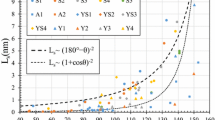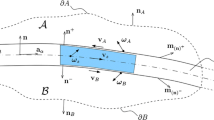Abstract.
For Newtonian flow through micro or nano sized channels, the no-slip boundary condition does not apply and must be replaced by a condition which more properly reflects surface roughness. Here we adopt the so-called Navier boundary condition for the sliding plate problem, which is one of the fundamental problems of fluid mechanics. When the no-slip boundary condition is used in the study of the motion of a viscous Newtonian fluid near the intersection of fixed and moving rigid plane boundaries, singular pressure and stress profiles are obtained, leading to a non-integrable force on each boundary. Here we examine the effects of replacing the no-slip boundary condition by a boundary condition which attempts to account for boundary slip due to the tangential shear at the boundary. The Navier boundary condition, possesses a single parameter to account for the slip, the slip length ℓ, and two solutions are obtained; one integral transform solution and a similarity solution which is valid away from the corner. For the former the tangential stress on each boundary is obtained as a solution of a set of coupled integral equations. The particular case solved is right-angled corner flow and equal slip lengths on each boundary. It is found that when the slip length is non-zero the force on each boundary is finite. It is also found that for a suffciently large distance from the corner the tangential stress on each boundary is equal to that of the classical solution. The similarity solution involves two restrictions, either a right-angled corner flow or a dependence on the two slip lengths for each boundary. When the tangential stress on each boundary is calculated from the similarity solution, it is found that the similarity solution makes no additional contribution to the tangential stress of that of the classical solution, thus in agreement with the findings of the integral transform solution. Values of the radial component of velocity along the line θ = π /4 for increasing distance from the corner for the similarity and integral transform solutions are compared, confirming their agreement for sufficiently large distances from the corner.
Similar content being viewed by others
Author information
Authors and Affiliations
Corresponding author
Additional information
(Received: November 9, 2005)
Rights and permissions
About this article
Cite this article
Matthews, M.T., Hill, J.M. Micro/nano sliding plate problem with Navier boundary condition. Z. angew. Math. Phys. 57, 875–903 (2006). https://doi.org/10.1007/s00033-006-0067-4
Published:
Issue Date:
DOI: https://doi.org/10.1007/s00033-006-0067-4




